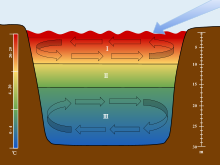
Back تطبق المياه Arabic Estratificació de l'aigua Catalan Temperaturschichtung German Estratificación del agua Spanish لایهبندی (آب) Persian Stratification de l'eau French Stratifikasi (air) ID Penstrataan (air) Malay Stratifikasjon i limnologi NN Estratificação aquática Portuguese

I. The Epilimnion
II. The Metalimnion
III. The Hypolimnion
Stratification in water is the formation in a body of water of relatively distinct and stable layers by density. It occurs in all water bodies where there is stable density variation with depth. Stratification is a barrier to the vertical mixing of water, which affects the exchange of heat, carbon, oxygen and nutrients.[1] Wind-driven upwelling and downwelling of open water can induce mixing of different layers through the stratification, and force the rise of denser cold, nutrient-rich, or saline water and the sinking of lighter warm or fresher water, respectively. Layers are based on water density: denser water remains below less dense water in stable stratification in the absence of forced mixing.
Stratification occurs in several kinds of water bodies, such as oceans, lakes, estuaries, flooded caves, aquifers and some rivers.